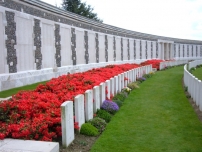| First Name: | John | Last Name: | BRODERICK | |
|---|---|---|---|---|
| Date of Death: | 20/11/1917 | Lived/Born In: | Wapping | |
| Rank: | Lance Corporal | Unit: | Rifle Brigade16 | |
| Memorial Site: | Tyne Cot Memorial, Belgium | |||
Current Information:Born-Wapping
Third Battle of Ypres This was a campaign fought between July and November 1917 and is often referred to as the Battle of Passchendaele, a village to the north-east of Ypres which was finally captured in November. It was an attempt by the British to break out of the Ypres salient and capture the higher ground to the south and the east from which the enemy had been able to dominate the salient. It began well but two important factors weighed against them. First was the weather. The summer of 1917 turned out to be one of the the wettest on record and soon the battlefield was reduced to a morass of mud which made progress very difficult, if not impossible in places. The second was the defensive arrangements of concrete blockhouses and machine gun posts providing inter-locking fire that the Germans had constructed and which were extremely difficult and costly to counter. For 4 months this epic struggle continued by the end of which the salient had been greatly expanded in size but the vital break out had not been achieved. 39th Division had been involved in the opening battle of Third Ypres and then again in mid September, 1917, during the Battle of the Menin Road, but for the first two weeks of October, 1917, they were away from the front line, undergoing training. They returned to the Ypres salient in the middle of October to take part in the fighting that marked the closing stages of 3rd Ypres. On 7th November, 1917, 16th Rifle Brigade of 117 Brigade took over part of the front line in the Tower Hamlets sector where they remained until 10th November on which date they moved back into support in Bodmin Copse. They were back in the front line on 16th November in the Polderhoek sector north of Gheluvelt from where they were relieved and moved back into reserve in the Torr Top Tunnels. Here they provided carrying parties taking supplies to the front line. According to the Battalion Diary five men, one of whom was John Broderick, were killed on 20th November but no further information was provided. Carrying parties were dangerous affairs. Tracks along which they had to travel to reach the front line were known to the German gunners and targeted accordingly and in all probability these five casualties came as a result of shell fire. |
||||
| « Back to Search Results | ||||
| If you think any of the information shown here is incorrect, Click Here to submit your amends and comments | ||||




